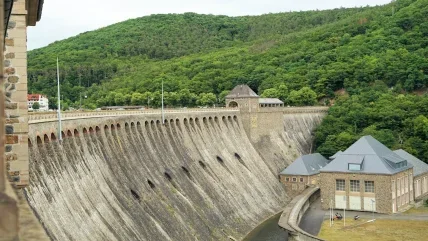
Inflation, a persistent rise in the general price level of goods and services, has significant repercussions across various sectors of the economy. The hydropower industry, a critical component of the global energy mix, is no exception. As inflation drives up the costs of raw materials, labour, and financing, it places considerable strain on the budgets and timelines of hydropower projects.
Additionally, the unpredictability of inflation can complicate long-term financial planning, making it challenging for stakeholders to forecast expenses and revenues accurately. This article explores the multifaceted impact of inflation on the hydropower industry, examining its effects on costs, investment, and project viability. It also highlights strategies for mitigating these challenges and ensuring the sustainability of hydropower projects.
By understanding and addressing these inflationary pressures, the hydropower sector can better navigate economic uncertainties and continue to contribute to the global transition towards renewable energy sources.
Understanding Inflation and Its Drivers
Inflation is driven by various factors, including increased demand, supply chain disruptions, rising production costs, and expansive monetary policies. In the context of the hydropower industry, these drivers can significantly influence the cost structures and financial planning of projects. Understanding these dynamics is essential for stakeholders to navigate the inflationary landscape effectively.
The Cost Implications of Inflation
Inflation directly impacts the cost of materials, labour, and financing, all of which are critical components of hydropower projects. The rising prices of construction materials such as steel, cement, and machinery can significantly escalate the initial capital expenditure required for building new hydropower plants. Additionally, inflation can drive up the costs of maintenance and repairs for existing facilities, impacting their operational efficiency and lifespan.
Labour Costs and Wage Inflation
The hydropower industry is labour-intensive, relying on a skilled workforce for construction, operation, and maintenance. Wage inflation, driven by increased competition for skilled labour and rising living costs, can elevate operational expenses. This, in turn, can affect the profitability and financial stability of hydropower projects, particularly those in regions with high inflation rates.
Financing Challenges
Inflation also affects the financing of hydropower projects. Rising interest rates, often implemented by central banks to curb inflation, can increase the cost of borrowing. This makes it more expensive for developers to secure loans and finance new projects. Additionally, inflation erodes the real value of future cash flows, making long-term investment less attractive and increasing the risk profile of hydropower projects.
Impact on Investment Decisions
Investors are acutely sensitive to inflation, as it influences the expected returns on their investments. High inflation can deter investment in hydropower projects by increasing uncertainty and reducing the predictability of financial outcomes. Moreover, inflation can lead to higher discount rates, lowering the present value of future earnings and making projects less financially viable.
Case Studies: Regional Impacts
Examining the impact of inflation on hydropower projects in different regions provides valuable insights. In countries like Brazil and Argentina, where inflation has been historically high, hydropower projects have faced significant cost overruns and delays. Conversely, in more stable economies such as Canada and Norway, inflation has had a relatively moderate impact, allowing for more predictable project planning and execution.
Strategies for Mitigation
To mitigate the impact of inflation, stakeholders in the hydropower industry can adopt several strategies:
1. Cost Management and Efficiency: Implementing stringent cost management practices and enhancing operational efficiency can help offset the rising costs of materials and labour. This includes optimising procurement processes, adopting innovative construction techniques, and leveraging technology for predictive maintenance.
2. Financial Hedging: Utilising financial instruments such as inflation-linked bonds and derivatives can protect against inflationary pressures. These tools can help lock in costs and stabilise cash flows, reducing the financial risk associated with fluctuating prices.
3. Long-Term Contracts: Negotiating long-term contracts with fixed pricing for materials and services can provide cost certainty and shield projects from short-term inflation spikes. This approach requires robust supplier relationships and strategic planning.
4. Diversified Financing: Diversifying financing sources and incorporating inflation-adjusted pricing mechanisms in power purchase agreements (PPAs) can enhance financial resilience. This includes exploring green bonds, public-private partnerships, and international funding options.
5. Regulatory Engagement: Engaging with regulators to ensure that tariff structures and regulatory frameworks account for inflationary pressures is crucial. This can involve advocating for tariff adjustments that reflect rising costs and ensure the financial sustainability of hydropower projects.
Future Outlook
As global economic conditions continue to evolve, the hydropower industry must remain adaptable to the challenges posed by inflation. Ongoing monitoring of inflation trends, proactive cost management, and strategic financial planning will be essential in navigating this complex landscape. Additionally, fostering innovation and sustainability within the industry can create new opportunities to mitigate the impact of inflation and enhance the resilience of hydropower projects.
Conclusion
Inflation presents significant challenges to the hydropower industry, impacting costs, investment decisions, and project viability. However, by adopting comprehensive strategies for cost management, financial hedging, and regulatory engagement, stakeholders can mitigate these challenges and ensure the continued growth and sustainability of the sector. As the hydropower industry navigates the inflationary pressures of the global economy, a proactive and adaptive approach will be key to securing its future in the energy landscape.






